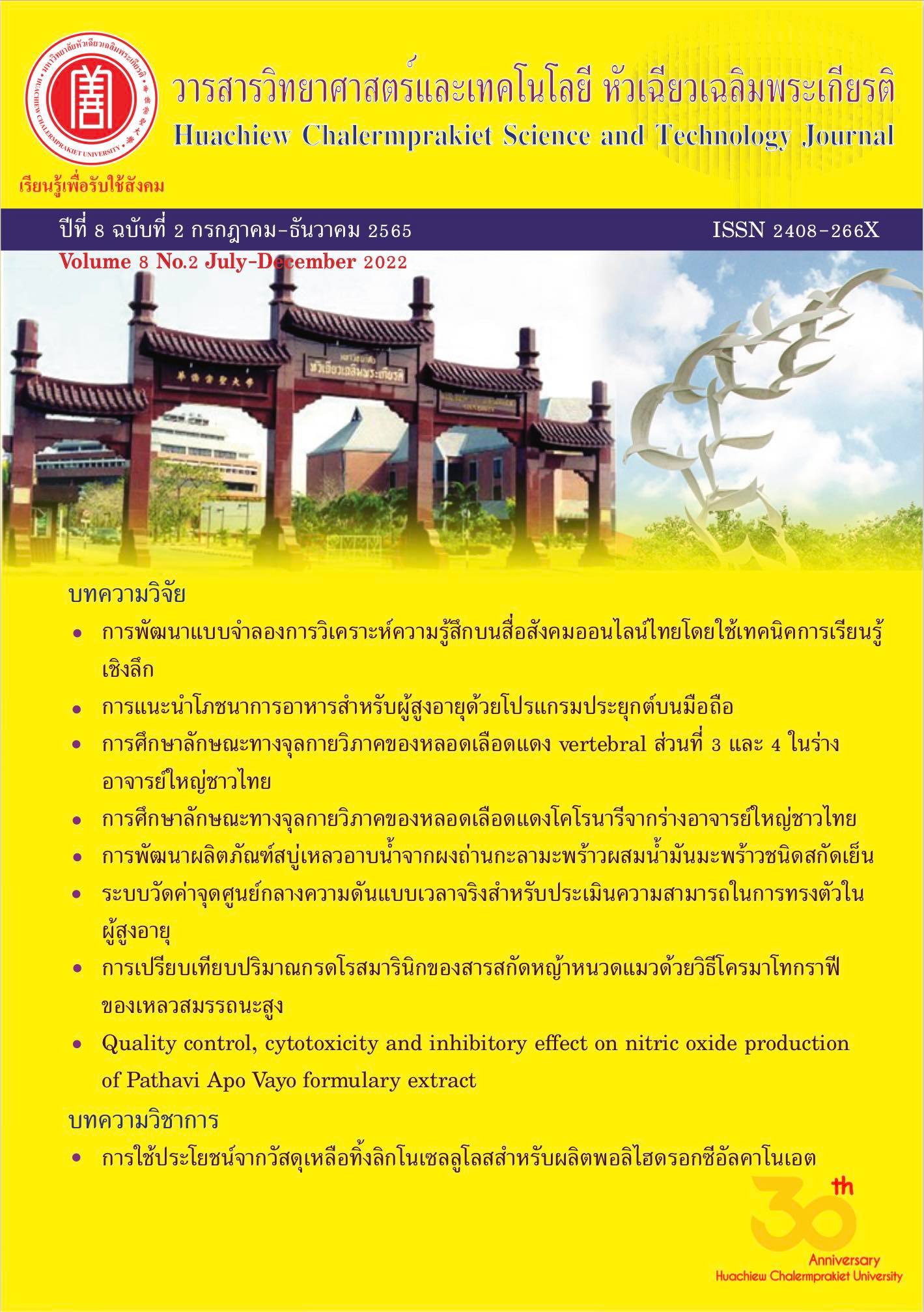การศึกษาลักษณะทางจุลกายวิภาคของหลอดเลือดแดงโคโรนารีจากร่างอาจารย์ใหญ่ชาวไทย
คำสำคัญ:
หลอดเลือดแดงโคโรนารี, จุลกายวิภาค , อาจารย์ใหญ่, ผนังหลอดเลือด, ผนังหลอดเลือดชั้นในบทคัดย่อ
โรคหัวใจและหลอดเลือดเป็นสาเหตุสำคัญของการเสียชีวิตของประชากรทั่วโลก และพบว่าการเกิดโรคหลอดเลือดตีบแข็ง (atherosclerosis) ในหลอดเลือดแดงโคโรนารี (coronary artery) มีการเพิ่มขึ้นอย่างรวดเร็วในผู้สูงอายุ ซึ่งงานวิจัยนี้มีวัตถุประสงค์เพื่อศึกษาลักษณะทางจุลกายวิภาคและความหนาของผนังหลอดเลือดแดงโคโรนารีด้านซ้าย (left coronary artery) และด้านขวา (right coronary artery) จากร่างอาจารย์ใหญ่ชาวไทยจำนวน 20 ร่าง อายุ 52-101 ปี ด้วยการย้อมสี Hematoxylin และ eosin และ Verhoeff-Van Gieson พบว่าผนังหลอดเลือดชั้นใน (tunica intima) ของหลอดเลือดแดงโคโรนารีด้านขวามีความหนามากกว่าผนังหลอดเลือดชั้นกลาง (tunica media) อย่างมีนัยสำคัญทางสถิติ (p < 0.05) และพบการสะสมของ foam cell เป็นจำนวนมากภายในผนังหลอดเลือดแดงโคโรนารีด้านซ้ายและด้านขวา ทั้งยังพบการเกิด plaque ในลักษณะอื่นๆ ได้แก่ lipid core, fibrous cap, calcifications และ cholesterol cleft และพบความผิดปกติของ internal และ external elastic lamina ที่มีลักษณะเป็นแนวตรง เรียงตัวซ้อนกัน แตกเป็นเศษ ๆ และขาดหลุดจากกัน แสดงให้เห็นว่าอายุ 50 ปีขึ้นไปจะมีการเปลี่ยนแปลงทางจุลกายวิภาคของผนังหลอดเลือด ซึ่งอาจจะนำไปสู่การเกิดโรคหลอดเลือดแดงตีบแข็งได้ ผลที่ได้จากงานวิจัยนี้จะเป็นข้อมูลพื้นฐานในการนำไปประยุกต์ใช้ในการประเมินความเสี่ยงและการเฝ้าระวังการเกิดโรคหลอดเลือดตีบแข็งได้
เอกสารอ้างอิง
Yoshizumi M, Abe J, Tsuchiya K, Berk BC, Tamaki T. Stress and vascular responses: atheroprotective effect of laminar fluid shear stress in endothelial cells: possible role of mitogen-activated protein kinases. J Pharmacol Sci 2003;91(3):172-6.
Messner B, Bernhard D. Smoking and cardiovascular disease: mechanisms of endothelial dysfunction and early atherogenesis. Arterioscler Thromb Vasc Biol 2014;34(3):509-15.
Falk E. Pathogenesis of atherosclerosis. J Am Coll Cardiol 2006;47(8):7-12.
Glass CK, Witztum JL. Atherosclerosis. the road ahead. Cell 2001;104(4):503-16.
Hansson GK. Inflammation, atherosclerosis, and coronary artery disease. N Engl J Med 2005;352(16):1685-95.
ศันสนีย์ วงศ์ไวศยวรรณ. ตำราพยาธิวิทยากายวิภาค เล่ม 1. พิมพ์ครั้งที่ 2. กรุงเทพฯ: โรงพิมพ์เดือนตุลา; 2555.
Bhandari BJ, Jadhav MN, Shetty AK, Kittur SK. Morphological analysis of coronary atherosclerosis by modified American heart association classification in young individuals an autopsy study. J Pathol 2018;8(2):67-72.
Deopujari R, Dixit A. The Study of Age related changes in coronary arteries and its relevance to the atherosclerosis. J Anat Soc India 2010;59(2):192-6.
Wu J, Xia S, Kalionis B, Wan W, Sun T. The role of oxidative stress and inflammation in cardiovascular aging. Biomed Res Int 2014;2014:1-13.
Milutinović A, Šuput D, Zorc-Pleskovič R. Pathogenesis of atherosclerosis in the tunica intima, media, and adventitia of coronary arteries: An updated review. Bosn. J Basic Med Sci 2020;20(1):21-30.
รุ่งรัตน์ นิลธเสน. ไนตริกออกไซด์กับโรคหลอดเลือดตีบแข็ง Nitric oxide and atherosclerosis. ว. วิทย. เทคโน. หัวเฉียวเฉลิมพระเกียรติ 2559;2(1):71-9.
Bennett MR, Sinha S, Owens GK. Vascular smooth muscle cells in atherosclerosis. Circ Res 2016;118(4):692-702.
BhanVadia VM, Desai NJ, Agarwal NM. Study of coronary atherosclerosis by modified american heart association classification of atherosclerosis-an autopsy study. J Clin Diagn Res 2013;7(11):2494-7.
Libby P, Ridker PM, Hansson GK. Progress and challenges in translating the biology of atherosclerosis. Nature 2011;473:317–25.
Bekkering S, Quintin J, Joosten LA, van der Meer JW, Netea MG, Riksen NP. Oxidized low-density lipoprotein induces long-term proinflammatory cytokine production and foam cell formation via epigenetic reprogramming of monocytes. Arterioscler Thromb Vasc Biol 2014;34(8):1731–8.
Bentzon JF, Otsuka F, Virmani R, Falk E. Mechanisms of plaque formation and rupture. Circ Res 2014;114(12):1852-66.
Virmani R, Kolodgie FD, Burke AP, Farb A, Schwartz SM. Lessons from sudden coronary death: a comprehensive morphological classification scheme for atherosclerotic lesions. Arterioscler Thromb Vasc Biol 2000;20(5):1262–75.
Dalager S, Paaske WP, Kristensen IB, Laurberg JM, Falk E. Artery-related differences in atherosclerosis expression: implications for atherogenesis and dynamics in intima-media thickness. Stroke 2007;38(10):2698-705.
Clarke MC, Bennett MR. Cause or consequence: what does macrophage apoptosis do in atherosclerosis?. Arterioscler Thromb Vasc Biol 2009;29(2):153–5.
Mori H, Torii S, Kutyna M, Sakamoto A, Finn AV, Virmani R. Coronary artery calcification and its progression: What does it really mean?. JACC Cardiovasc Imaging 2018;11(1):127-42.
Demer LL, Tintut Y. Vascular calcification: pathobiology of a multifaceted disease. Circulation 2008;117(22):2938-48.
Liu W, Zhang Y, Yu CM, Ji QW, Cai M, Zhao YX, et al. Current understanding of coronary artery calcification. J Geriatr Cardiol 2015;12(6):668-75.
Pranjali R, Sachin S. Histology of coronary arteries in relation to the coronary sclerosis. J Anat 2018;2(2):1-6.
Venkateshwer M, Pusala B. Anatomical variations in branching pattern and dimensions of coronary arteries: a cadaveric study from south India. J Dent Med Sci 2016;15(8):21-8.
Bocan TMA, Schifani TA, Guyton JR. Ultrastructure of the human aortic fibrolipid lesion. Formation of the atherosclerotic lipid-rich core. Am J Pathol 1986;123(3):413-24.
Shembekar S, Meshram M. Age Related Histological Changes in Tunica Intima of Coronary Arteries in Relevance to the Atherosclerosis. Indian J Forensic Med Toxicol 2016;10(2):168-71.
ดาวน์โหลด
เผยแพร่แล้ว
รูปแบบการอ้างอิง
ฉบับ
ประเภทบทความ
สัญญาอนุญาต
ลิขสิทธิ์ (c) 2022 วารสารวิทยาศาสตร์และเทคโนโลยี หัวเฉียวเฉลิมพระเกียรติ

อนุญาตภายใต้เงื่อนไข Creative Commons Attribution-NonCommercial-NoDerivatives 4.0 International License.
บทความทุกบทความที่ได้รับการตีพิมพ์ถือเป็นลิขสิทธิ์ของ คณะวิทยาศาสตร์และเทคโนโลยี มหาวิทยาลัยหัวเฉียวเฉลิมพระเกียรติ



